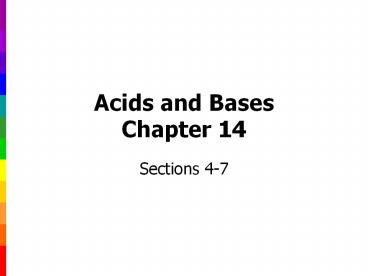Acids and Bases Chapter 14 PowerPoint PPT Presentation
1 / 12
Title: Acids and Bases Chapter 14
1
Acids and BasesChapter 14
- Sections 4-7
2
Sample Exercise 14.7
- Calculate the pH of 0.10 M HNO3
- Calculate the pH of 1.0 x 10-10 M HCl
3
Sample Exercise 14.8
- The hypochlorite ion (OCl-) is a strong oxidizing
agent often found in household bleaches and
disinfectants. It is also the active ingredient
that forms when swimming pool water is treated
with chlorine. In addition to its oxidizing
abilities, the hypochlorite ion has a relatively
high affinity for protons (it is a much stronger
base than Cl- , for example) and forms the weakly
acidic hypochlorous acid (HOCl, Ka 3.5 x 10-8).
Calculate the pH of a 0.100M aqueous solution of
hypochlorous acid.
4
Sample Exercise 14.9
- Calculate the pH of a solution that contains 1.00
M HCN (Ka 6.2 x 10-10) and 5.00 M HNO2 (Ka
4.0 x 10-4). Also calculate the concentration of
a cyanide ion (CN-) in this solution at
equilibrium.
5
Sample Exercise 14.10
- Calculate the percent dissociation of acetic acid
(Ka 1.8 x 10-5) in each of the following
solutions. - 1.00 M HC2H3O2
- 0.100 M HC2H3O2
6
Sample Exercise 14.11
- Lactic acid (HC3H5O3) is a waste product that
accumulates in muscle tissue during exertion,
leading to pain and a feeling of fatigue. In a
0.100 M aqueous solution, lactic acid is 3.7
dissociated, Calculate the vale of Ka for this
acid.
7
Sample Exercise 14.12
- Calculate the pH of 5.0 x 10-2 M NaOH solution.
8
Sample Exercise 14.13
- Calculate the pH for a 15.0 M solution of NH3 (Kb
1.8 x 10-5)
9
Sample Exercise 14.14
- Calculate the pH of a 1.0 M solution of
methylamine (Kb 4.38 x 10-4)
10
Polyprotic Acids
- Dissociate in a step wise manner
- Each successive Ka value for dissociation
equilibria are Ka1 and Ka2 - Ka1 gt Ka2 gt Ka3
- INSERT TABLE 14.4 page 651
- Only the first dissociation step makes an
important contribution to H - EXCEPTSulfuric Acid is strong in the first
dissociation and weak in the second dissociation.
SO the second dissociation does make a
contribution to H.
11
Sample Exercise 14.15
- Calculate the pH of a 5.0 M H3PO4 solution and
the equilibrium concentration of the species
H3PO4, H2PO41-, HPO42-, PO43-
12
Sample Exercise 14.16
- Calculate the pH of a 1.0 M H2SO4 solution.
13
Sample Exercise 14.17
- Calculate the pH of a 1.00 x 10-2 M H2SO4
solution.

